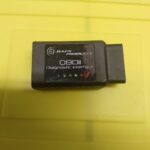The automotive industry is constantly evolving, and with it, the technology used to diagnose and repair vehicles. One crucial aspect of this evolution is the On-Board Diagnostics (OBD) system. This article delves into the key differences between OBD1 and OBD2, answering the question: “Que Significa Obd1 Y Obd2?” – what does OBD1 and OBD2 mean? We’ll explore their history, functionalities, and why understanding these systems is essential for both car owners and mechanics.
The Evolution of On-Board Diagnostics
The need to monitor vehicle performance and emissions led to the development of OBD systems. Initially, OBD1 emerged as a rudimentary system for diagnosing engine problems. However, its limitations paved the way for the more advanced and standardized OBD2 system. Both systems aim to provide insights into a vehicle’s health, but they differ significantly in their capabilities and implementation.
Understanding OBD1: The Precursor
OBD1, the first generation of on-board diagnostics, focused primarily on monitoring emissions. Its capabilities were limited, lacking standardization across car manufacturers. Each manufacturer developed its own proprietary connector and diagnostic codes, making it challenging for mechanics to diagnose issues across different vehicle makes and models. OBD1 primarily monitored components related to emissions control, providing a basic level of diagnostic information.
Understanding OBD2: The Standardized Solution
Introduced in 1996, OBD2 revolutionized vehicle diagnostics. It mandated a standardized 16-pin connector and a universal set of diagnostic trouble codes (DTCs), ensuring compatibility across all vehicle makes and models sold in the United States. This standardization simplified the diagnostic process for mechanics and provided car owners with more accessible information about their vehicle’s health. OBD2 monitors a wider range of systems, including engine performance, emissions, transmission, and other critical components.
Key Differences Between OBD1 and OBD2
The differences between OBD1 and OBD2 are substantial:
- Standardization: OBD2 boasts a standardized connector and DTCs, unlike OBD1’s manufacturer-specific systems. This allows for universal diagnostics across different vehicle makes.
- Diagnostic Depth: OBD2 offers more comprehensive diagnostics, covering a broader range of vehicle systems and providing more detailed information than OBD1.
- Global Applicability: OBD2 became a global standard, adopted by various countries, facilitating consistent vehicle diagnostics worldwide. OBD1 lacked this widespread adoption.
- Diagnostic Codes: OBD1 used varying code formats, while OBD2 employs a standardized alphanumeric code structure (e.g., P0300 for a random misfire). This structured format simplifies code interpretation.
OBD Systems in the Modern Automotive Landscape
While OBD2 remains the current standard, the automotive landscape continues to evolve with the rise of electric vehicles (EVs) and increasingly complex vehicle systems. Future iterations of OBD systems will likely need to adapt to these technological advancements. However, the core principles of standardized diagnostics and comprehensive monitoring established by OBD2 will likely remain foundational.
Conclusion
Understanding the difference between OBD1 and OBD2 is crucial for anyone involved in vehicle maintenance and repair. OBD2’s standardization and comprehensive diagnostic capabilities significantly improved upon the limitations of OBD1. As vehicle technology continues to advance, OBD systems will likely continue to evolve, building upon the foundation laid by OBD2.
